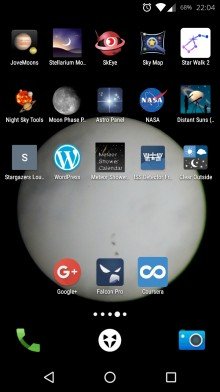Over the course of the last week or so I was lucky enough to be able to do something that I thoroughly enjoy: I did some public stargazing sessions. As part of the recent Dorchester Try This 2016, I did three sessions in the car park up at Maiden Castle, and, all told, over 30 people attended (most of whom had never looked through a telescope before). Over the course of the three sessions we got to look at Mars and Saturn; individual and binary stars, such as Arcturus, Antares, Vega, Alcor, Mizar, Almaak and Albireo (and clearly discerned the colour differences); open star clusters, such as the Owl and Perseus double clusters; and the amazing globular cluster Messier 13. We also saw the Ring and Veil nebulae in Lyra and Cygnus respectively; and the Andromeda, Whirlpool, Cigar and Bodes galaxies (plus some of the Perseids).
Incidentally, it has to be said that Maiden Castle is an excellent observing site. I was very surprised to find that, despite the lights of Poundbury, Dorchester and Weymouth, I was able to see the Milky Way, the Perseus double cluster and Andromeda with the naked eye, and the Veil nebula (a very faint object requiring special eyepiece filters to see) was very clear.
A session with a couple of Scouts troops, at their camp near Sydling, took the total number of people who got to look through a telescope for the first time to around 50! All in all, a tiring but incredibly positive week. There was so much enthusiasm, and so many exclamations of ‘wow!’, and ‘fantastic!’. It was a real thrill to be involved.
I believe that what most of those who came along took away from the sessions was just how easy it is to find amazing objects in the night sky. A moderate pair of binoculars (such as 10x50s) will allow you to see star clusters and the larger/brighter galaxies, while an easy to use telescope (on an Alt/Az or Dobsonian mount) offering magnifications of between x40 and x150, will let you see pretty much all of the 110 objects on the Messier catalogue, the rings of Saturn, and the bands and moons of Jupiter, and much more. Okay … and you’ll also get amazing views of the moon, should you wish …
Smartphone apps such as Star Walk, Stellarium, Sky Map, Distant Suns, etc, will help you to find these objects, and will help you identify the constellations. For those who prefer their information in print form, Sky & Telescope’s Pocket Sky Atlas is highly recommended.
For a long time, despite a long-standing interest in astronomy, I’d managed to convince myself that stargazing was only for rich ‘astro-boffins’, rather than something the average person on the street could do. My early experiences with a terrible telescope on a wobbly mount reinforced this conviction. It was only much later, when I’d found the ‘right’ telescope for me that I realised how wrong I’d been. All you really need, of course, is to go outside and look up …
I’d like to send a very big ‘thank you’ to the folks who organised Dorchester Try This 2016, and also to all those who took the first steps forward into this fascinating and exhillirating hobby.
What’s up?
We’ve got another week or so of dark evening skies before the moon returns in force, and is full again on the 18th. The Perseids peak on the 12th of August, but run through until the 24th. Mars and Saturn will be bright in the south for a little while longer, and Saturn is looking particularly good at the moment. Neptune and Uranus are both possible at this time of year, in the east and south-east respectively. A couple of more difficult objects on my list in the coming weeks are the Little Gem nebula and the Saturn Nebula, both ideally placed in the south.
Finally, for those up late enough (around 1am), if you look towards the east, just below the constellation of Perseus, you might just see the Pleiades rising. Autumn is coming 🙂
Clear skies!
Kevin Quinn is an amateur astronomer based in Cerne Abbas. He is the proud owner of a ten-inch reflector, a small refractor, a case of eyepieces, and a couple of pairs of binoculars. He tweets via @CerneAstro, and blogs (occasionally) via theastroguy.wordpress.com.
©Kevin Quinn







